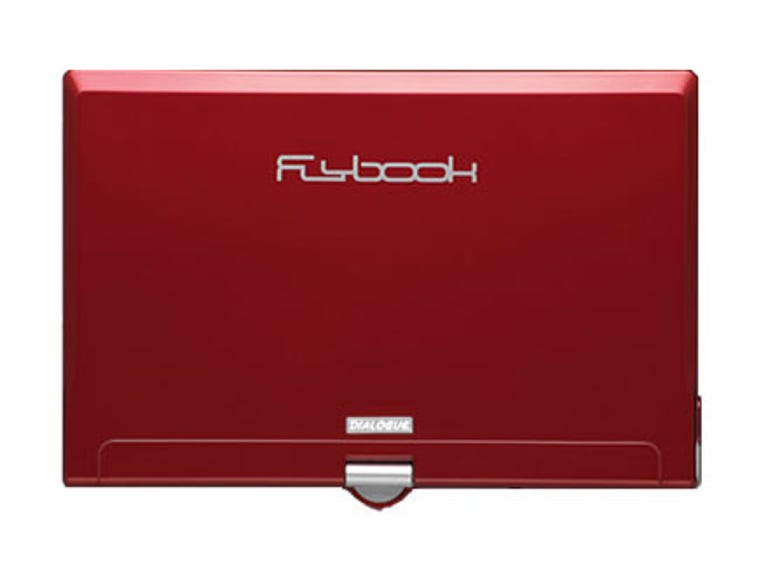 Why You Can Trust CNET
Why You Can Trust CNET Flybook by Dialogue review: Flybook by Dialogue
While it's technically packed with add-on features, the poor basic performance of the Flybook makes it a bad choice for anyone seeking an ultraportable notebook.
Design
The Dialogue Flybook is highly reminiscent of Sony's ultra-cute and ultra-portable VAIO VGN-T27GP; both are super-miniscule notebooks with very small keyboards and screens that are only slightly harder to carry around than the average PDA, albeit a fair amount more powerful. The flybook edges out the Sony model in the weight stakes, just barely, at 1.2kg and at 235x140x30mm it's certainly slim and small. The glossy finish of the exterior flips out to reveal a standard but small 80-key notebook keyboard, and, unusually, a trackpoint and mouse buttons located at the top of the keyboard rather than the bottom. The screen for the flybook also swivels out, as the unit has Windows XP Tablet Edition style features, although it isn't running the Tablet OS for some inexplicable reason. Instead, it uses a third party application on top of Windows XP Home. Given the market for Tablets is largely in the vertical corporate sector, where XP Pro would be a better fit, this is an unusual design decision to say the least. It isn't alone in the unusual design school, however.
The Good
The Bad
The Bottom Line
The screen on the flybook is an 8.9" TFT with a top resolution of 800x600, which is both smaller and lower resolution than the comparable Sony model. Admittedly, at this kind of screen size, that's probably a moot issue, and you certainly can't crank the flybook's resolution up to uncomfortably small levels as you can with the Sony.
Features
On paper, the Flybook looks like it's got a little bit of everything and then some more thrown in for good measure. It's powered by a Transmeta Crusoe processor clocked at 1GHz, with 512MB of DDR SDRAM, a 40GB hard drive and no optical drive whatsoever. USB and Firewire ports are present -- although in our test sample, the USB ports were detected as older non-Hi-Speed USB ports, which is a bit of a concern.
Where the flybook really stands out is in network connectivity. It's got a standard LAN port, as well as WiFi, Bluetooth, and unusually, a GSM socket for mobile phone sim cards, making this perhaps the world's biggest mobile phone. The WiFi connectivity on the flybook is only the older style 802.11b, however.
Performance
We tested the Flybook with Bapco's MobileMark 2002, or at least, we tried to. It steadfastly refused to complete that benchmark's performance-based testing, grinding to a halt with a variety of errors across multiple applications. It did, however, manage to make its way through the less processor-intensive reader test, notching up 197 minutes of battery life before conking out. Given that many desktop replacement notebooks with big shiny battery-hungry screens manage that kind of score, it's not exactly a stunning battery performance.
On less scientific anecdotal testing, things didn't really improve. While it's capable of most basic computing tasks, the low specification processor, slower-speed USB ports and positively ancient 802.11b networking made for a rather tepid and laborious experience.
As with the comparable Sony notebook, typing on the Flybook is also somewhat challenging, due to the very small and cramped keyboard. Where the flybook makes it worse, however, is in the absolutely insane design decision that saw the mouse trackpoint and buttons located above the keyboard, rather than at the bottom. You could get used to it in time, but it's totally counter-intuitive compared to every other notebook on the market, and makes even simple Web browsing a challenging and at times irritating experience.
The lack of an optical drive, rather tepid notebook performance and high asking price of the flybook make it something of a non-starter, especially compared to the similarly priced, much better equipped Sony alternative, so unless the GSM capabilities of the Flybook really, really appeal to you, we'd suggest you steer well clear.


